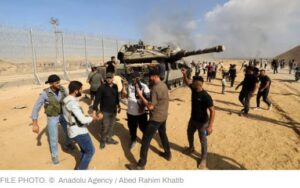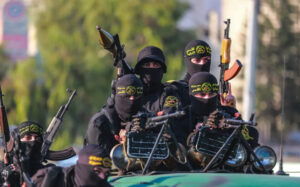
Anak Gaza terluka ditembak Israel
STRATEGIC ASSESSMENT. The validity of the motives for the May escalation of clashes between Israel and the Gaza Strip-based Palestinian militant group Palestine Islamic Jihad (PIJ) is subject to significant debate. The two sides have diametrically opposed and seemingly irreconcilable narratives for the genesis, scope, and potential resolution of the Israeli-Palestinian dispute. In their public messaging, each side presents a narrative that accuses the other side of provocation or aggression. PIJ launched a round of rocket and missile attacks on Israel in April, from both Gaza as well as positions in southern Lebanon, to message intense opposition to Israel’s crackdown on Palestinian protests at the Al Aqsa Mosque in Jerusalem. The PIJ’s attacks sparked Israeli airstrikes in retaliation. Even though some rockets were fired from Lebanese territory controlled by key Tehran ally, Lebanese Hezbollah, Israel pointedly messaged that it did not want a broad conflict – either with heavily armed Hezbollah or with Iran – by confining its retaliatory air strikes to PIJ targets in Gaza and south Lebanon. Significantly, Israeli leaders indicated that, although Hezbollah might have been in a position to prevent the launches from south Lebanon, they were not specifically accusing Hezbollah of facilitating the attacks. The clashes remained limited, and hostilities ceased after a few days.

Yet, the calm did not hold for even one month, and has escalated substantially. To signal steadfast resistance to Israel’s policies and retaliatory strikes, captured PIJ figure Khader Adnan went on a nearly three-month hunger strike, dying in early May while in Israeli custody. PIJ cited his death as justification to renew its attacks on Israel, launching a barrage of missiles and rockets from Gaza. Israeli leaders decided to send a message not only PIJ but also PIJ’s main backers in Tehran – the Islamic Revolutionary Guard Corps – Qods Force (IRGC-QF) – that Israel is capable of using overwhelming force to degrade the PIJ leadership at a time and place of Tel Aviv’s choosing. On May 9, Israeli officials stated that Tel Aviv would conduct retaliatory strikes for several days to eliminate PIJ leadership, in addition to the rocket and missile manufacturing infrastructure that the IRGC-QF has helped PIJ develop in Gaza. Israeli military officials made a point of the fact that they simultaneously targeted and killed PIJ leaders in separate locations to demonstrate Israel’s ability to deliver a devastating blow to the organization. Over five days, the strikes killed 18 PIJ operatives, according to Israeli Defense Force (IDF) officials, including three PIJ commanders. Numerous others, including civilians and young children, have also been killed in the latest round of fighting.

Through their application of significant force, Israeli leaders also clearly messaged Hamas that its leaders and infrastructure would suffer a similar fate if it joined the PIJ attacks on Israel. That implied threat plays on Hamas’ need to successfully govern and provide humanitarian and other aid and provisions to the Palestinian people in Gaza, and appeared to succeed in keeping Hamas on the sidelines. Hamas also seeks to avoid causing Israel to deny permits for Palestinians to work in Israel – income that is crucial to the Gaza economy. Still, Hamas leaders have provided rhetorical support to the PIJ attacks, reflecting Hamas’ alignment with PIJ’s view that the attacks on Israel are justified. Hamas also seeks to avoid ceding popular support to PIJ, which competes with Hamas for allegiance, recruits and foreign donations. Palestinians in Gaza and the West Bank, Iranian leaders, and other critics of Israel cited the civilian deaths in Gaza caused by the Israeli air strikes to promote a broader narrative that Israel is an aggressor that ignores the civilian cost of its military operations. IDF officials attempted to downplay the unintended consequences of their operations, and offered their own assessment of the number of civilians killed during the clashes.
For its part, PIJ sought to signal to Israel that the application of military power alone would not cow or deter the group, and that the group was capable of disrupting Israelis’ daily lives. On May 11, PIJ escalated its attacks by firing longer-range rockets at Jerusalem and at various small cities in Israel, killing one Israeli citizen and injuring several others. Videos showed Israelis jumping out of vehicles and crouching beneath highway rails or scrambling for cover as the sirens sounded. “The bombing of Jerusalem sends a message,” Islamic Jihad said in a statement after it fired rockets toward the capital: “What is happening in Jerusalem is not separate from Gaza.” The group also threatened to continue firing rockets into Israel all the way up to the controversial “Jerusalem Day” march in Israel, falling this year on May 19, which typically brings thousands of flag-waving Israeli nationalists through Palestinian parts of Jerusalem to celebrate the anniversary of the city’s reunification in 1967. The annual event has been blamed for ratcheting up Israeli-Palestinian tensions: in 2021, Hamas fighters fired rockets at Jerusalem during the march, setting off 11 days of clashes.

Several Arab states in the region, including Egypt and Qatar, sought to mediate a cessation of hostilities, which was finally announced over the weekend. Both Cairo and Doha maintain close contacts with PIJ leaders and also wield significant influence with Hamas, which is in a position to compel PIJ to stop its attacks. PIJ demanded, as a condition of a ceasefire, that Israel halt assassinations of its leaders – a demand that Israeli leaders categorically rejected. Both sides continued for several days to reject Arab proposals for a ceasefire that would permit humanitarian aid to flow to Gaza, and both signaled that they were prepared to dig in for sustained conflict if necessary. On May 13, PIJ’s armed wing said that: “The resistance prepared itself for months of confrontation,” and Israeli National Security Adviser Tzachi Hanegbi told a Jerusalem audience: “We’re not holding ceasefire talks,” adding that Israel’s top priority was to degrade PIJ’s capabilities. Still, Israeli leaders remained mindful that Israel’s Arab neighbors insisted on a return to a measure of regional stability. PIJ’s apparent dropping of its core demand to end Israeli targeted killings seemed to give Tel Aviv sufficient grounds to accept Egypt’s urgings for a ceasefire. Late on May 13, Egypt announced that the parties had agreed to a ceasefire to take effect at 10 PM local time that night. However, no long-term solution to the wide differences between the combatants was announced, and most experts expect that fighting will resume in the not-too-distant future (TSC).





